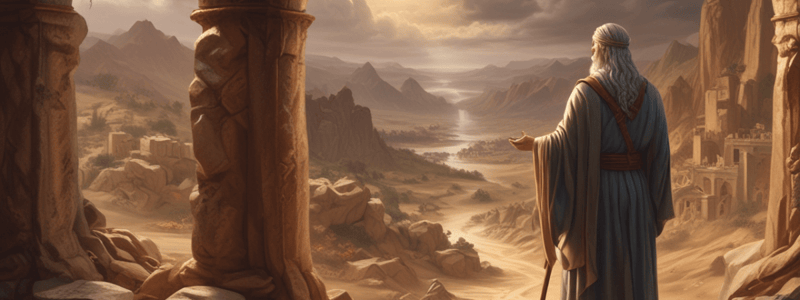Podcast
Questions and Answers
The decree of Cyrus mentioned in Ezra 1:1-4 refers to the rebuilding of the city.
The decree of Cyrus mentioned in Ezra 1:1-4 refers to the rebuilding of the city.
False (B)
The temple treasures were taken from the Jews and given to the Gentiles.
The temple treasures were taken from the Jews and given to the Gentiles.
False (B)
Zerubbabel was also known as Sheshbazzar, the appointed governor of the Jews.
Zerubbabel was also known as Sheshbazzar, the appointed governor of the Jews.
True (A)
The list of returning Jews in Ezra 2 is also found in Nehemiah 7:6-73.
The list of returning Jews in Ezra 2 is also found in Nehemiah 7:6-73.
There were 49,897 people registered, along with a small number of animals.
There were 49,897 people registered, along with a small number of animals.
Most of the Jews had returned to their Promised Land after being settled in Babylon.
Most of the Jews had returned to their Promised Land after being settled in Babylon.
The people of the land, also known as the Samaritans, were allowed to assist the Jews in their work.
The people of the land, also known as the Samaritans, were allowed to assist the Jews in their work.
The work on the temple continued uninterrupted after it was started.
The work on the temple continued uninterrupted after it was started.
The priests offered six male goats for the six tribes of Israel.
The priests offered six male goats for the six tribes of Israel.
The work of the temple finished solely because of the efforts of Zerubbabel and Joshua.
The work of the temple finished solely because of the efforts of Zerubbabel and Joshua.
The Book of Zechariah deals with a different period of time than the rebuilding of the temple.
The Book of Zechariah deals with a different period of time than the rebuilding of the temple.
Haggai's messages were meant to discourage the people from finishing the temple.
Haggai's messages were meant to discourage the people from finishing the temple.
Tatnai the governor was not within his rights asking about the building program.
Tatnai the governor was not within his rights asking about the building program.
It is wrong for God's people to claim their rights as citizens.
It is wrong for God's people to claim their rights as citizens.
The people were progressing rapidly with the rebuilding of the temple due to the ministry of the two prophets.
The people were progressing rapidly with the rebuilding of the temple due to the ministry of the two prophets.
Flashcards are hidden until you start studying
Study Notes
Rebuilding the Temple
- Cyrus, the Persian ruler, conquered Babylon in 539 B.C. and allowed the Jews to return to their land and rebuild their temple (Ezra 1:1-4, Isaiah 44:28-45:3)
- Cyrus's decree, issued in 538 B.C., was a fulfillment of Scripture and extended to other displaced nations and their gods
- The decree did not confuse with the one in Dan. 9:25, which refers to the rebuilding of the city and is dated 445 B.C.
The Precious Things
- The Spirit of God worked in the hearts of the people and their captors, and the temple treasures were restored to the Jews (Ezra 1:5-11)
- The Gentiles also gave freewill contributions for their temple (2 Chron. 36:7, Dan. 1:2)
- Sheshbazzar, also known as Zerubbabel, was the appointed governor
The People
- About 50,000 Jews returned to their own land, leaving the safety and luxury of Babylon (Ezra 2)
- The list of returning Jews is cited in Neh. 7:6-73 and divided into groups: leaders, families, towns, priests, Levites, Nethinim, and Solomon's servants
- The word "tirshatha" in Ezra 2:63 refers to Zerubbabel
- The total number of people registered was 49,897, along with a multitude of animals
Establishing the Altar
- The altar was the center of Jewish worship, and the people feared their powerful neighbors but knew God would protect them if they obeyed Him (Ezra 3:1-6)
- The altar was established in the seventh month, during the Feasts of Trumpets and Tabernacles (Num. 29:1-6, Lev. 23:23-25)
Laying the Foundation
- The people gave offerings, and the king provided materials to rebuild the temple (Ezra 3:7-13)
- The Levites led the way in the work, and the people sang and shouted when the foundation was laid
- God was doing the impossible in this situation (Jer. 33:1-11)
Resisting the Enemy
- Satan, the enemy, opposes and hinders the work of God (Ezra 4)
- The people of the land, including the Samaritans, offered to assist the Jews but were refused due to their false religion (2 Kings 17)
- The people of the land hired men at court to resist the Jews, and the work ceased for nearly 15 years (534-520 B.C.)
Resuming the Work
- The Word of God, proclaimed by Haggai and Zechariah, encouraged the workers to resume the work (Ezra 5)
- The preaching of God's Word is the secret of victory in any work of God
- God's Word encouraged Joshua and Zerubbabel, and God's eye was upon them (Ezra 5:5)
- The people labored and finished the temple from 520-515 B.C.
Studying That Suits You
Use AI to generate personalized quizzes and flashcards to suit your learning preferences.




